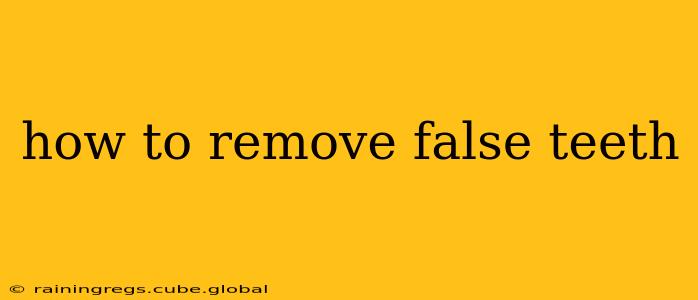Removing dentures, whether full or partial, requires a gentle and careful approach to avoid damaging the dentures themselves or your gums. This guide provides a step-by-step process, addresses common concerns, and offers helpful tips for maintaining your oral health.
What type of dentures do I have?
Before we dive into the removal process, it's crucial to understand the type of dentures you have. This will slightly influence the technique. The two main types are:
- Full dentures: These replace all the teeth in either your upper or lower jaw, or both.
- Partial dentures: These replace only some of your teeth and typically have clasps that attach to your remaining natural teeth.
The removal technique will be slightly different depending on the type, but the general principles remain the same.
How to Remove Full Dentures
Removing full dentures requires a bit more finesse. Here's a step-by-step guide:
-
Wash your hands: Thoroughly wash your hands with soap and water to maintain hygiene.
-
Break the seal: Gently use your thumbs to apply pressure, breaking the suction seal between your gums and the dentures. Start at the back of your mouth and work your way forward. This may take some practice, and you may need to try slightly different angles. Don't force it; forcing can injure your gums.
-
Remove the dentures: Once the seal is broken, gently rock the dentures back and forth to loosen them further. Then, use your index fingers and thumbs to carefully remove the dentures, pulling straight down (for lower dentures) or straight out (for upper dentures).
-
Rinse and clean: After removing your dentures, rinse them thoroughly with cool water. Clean them using a denture brush and cleanser, following the instructions provided with your denture cleaner.
How to Remove Partial Dentures
Partial dentures are often easier to remove because they utilize clasps that attach to your natural teeth.
-
Wash your hands: As with full dentures, wash your hands thoroughly.
-
Locate the clasps: Identify the clasps holding the denture in place.
-
Gently remove the clasps: Use your fingers to carefully unhook the clasps from your natural teeth. Work slowly and gently to avoid damaging your natural teeth or the denture.
-
Remove the denture: Once the clasps are unhooked, carefully remove the partial denture.
-
Rinse and clean: Rinse and clean your partial dentures thoroughly with cool water and a denture brush and cleaner.
What if I'm having trouble removing my dentures?
If you're struggling to remove your dentures, do not force them. This could cause injury to your gums and teeth. Try these tips:
- Use a mirror: A mirror can help you see the clasps or the seal and provide better control.
- Use a little water: A small amount of water between the dentures and your gums can help break the seal.
- Consult your dentist: If you consistently have difficulty removing your dentures, consult your dentist. They can provide personalized advice and address any underlying issues.
How often should I remove my dentures?
It's recommended to remove your dentures at night to allow your gums to rest and to facilitate proper cleaning. This also prevents bacterial buildup.
What should I do with my dentures after removing them?
Store your dentures in a denture case filled with water or denture soaking solution. This keeps them moist and prevents warping. Never leave them to dry out.
How do I clean my dentures?
Cleaning your dentures is crucial for maintaining oral hygiene. Use a soft-bristled denture brush and a denture cleaning solution. Avoid using abrasive cleaners or toothpastes, as these can scratch the surface of the dentures.
By following these steps and practicing regularly, you can confidently and safely remove your false teeth, ensuring both your comfort and oral health. Remember, if you experience persistent discomfort or difficulty, always seek guidance from your dentist.
